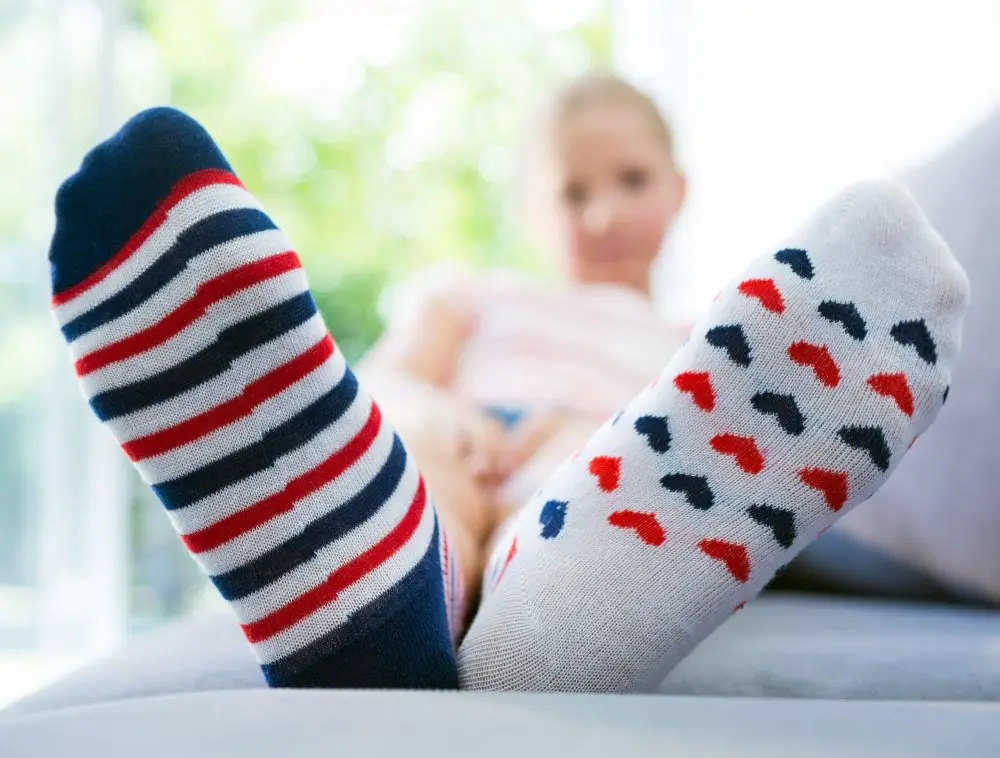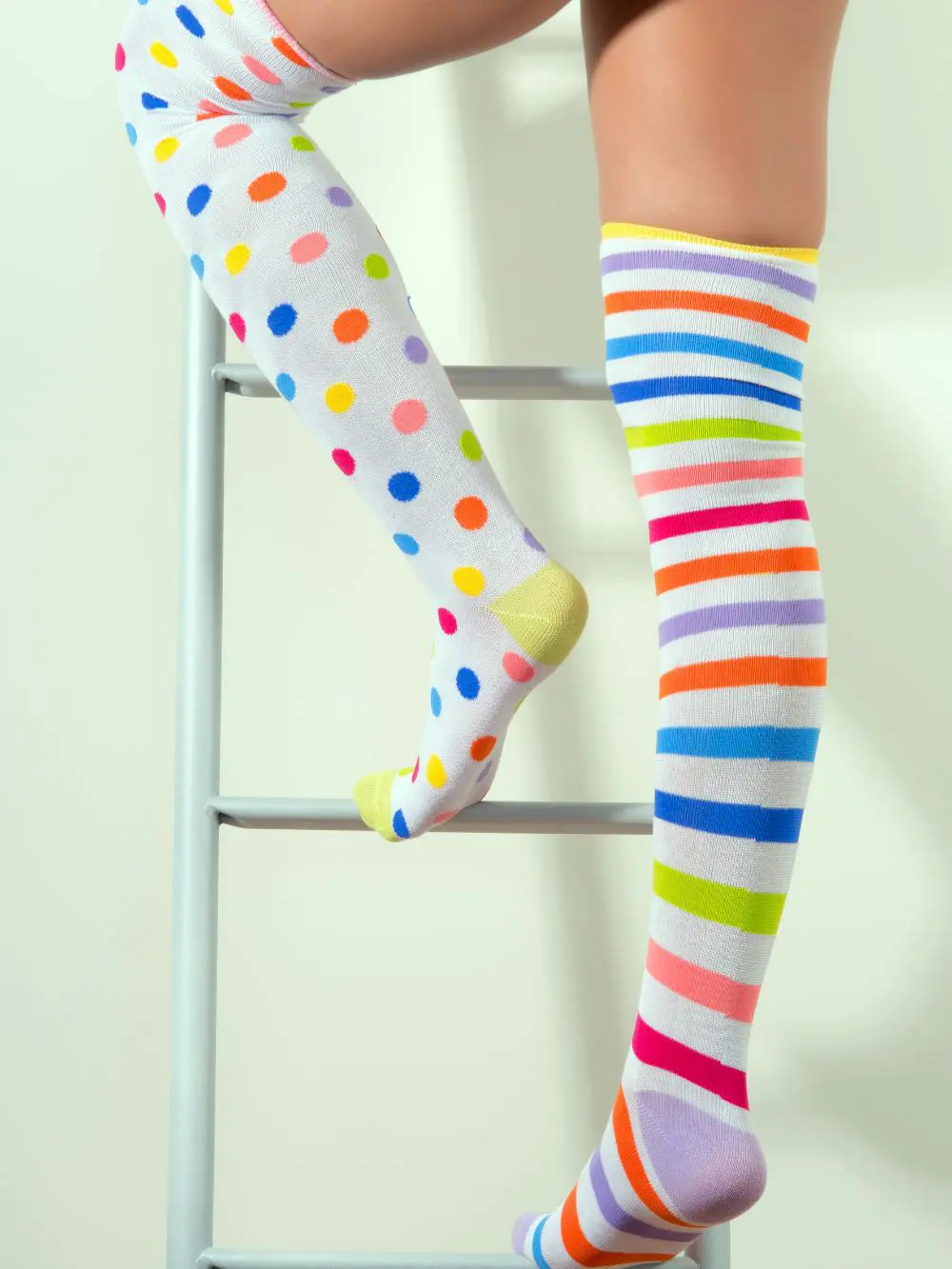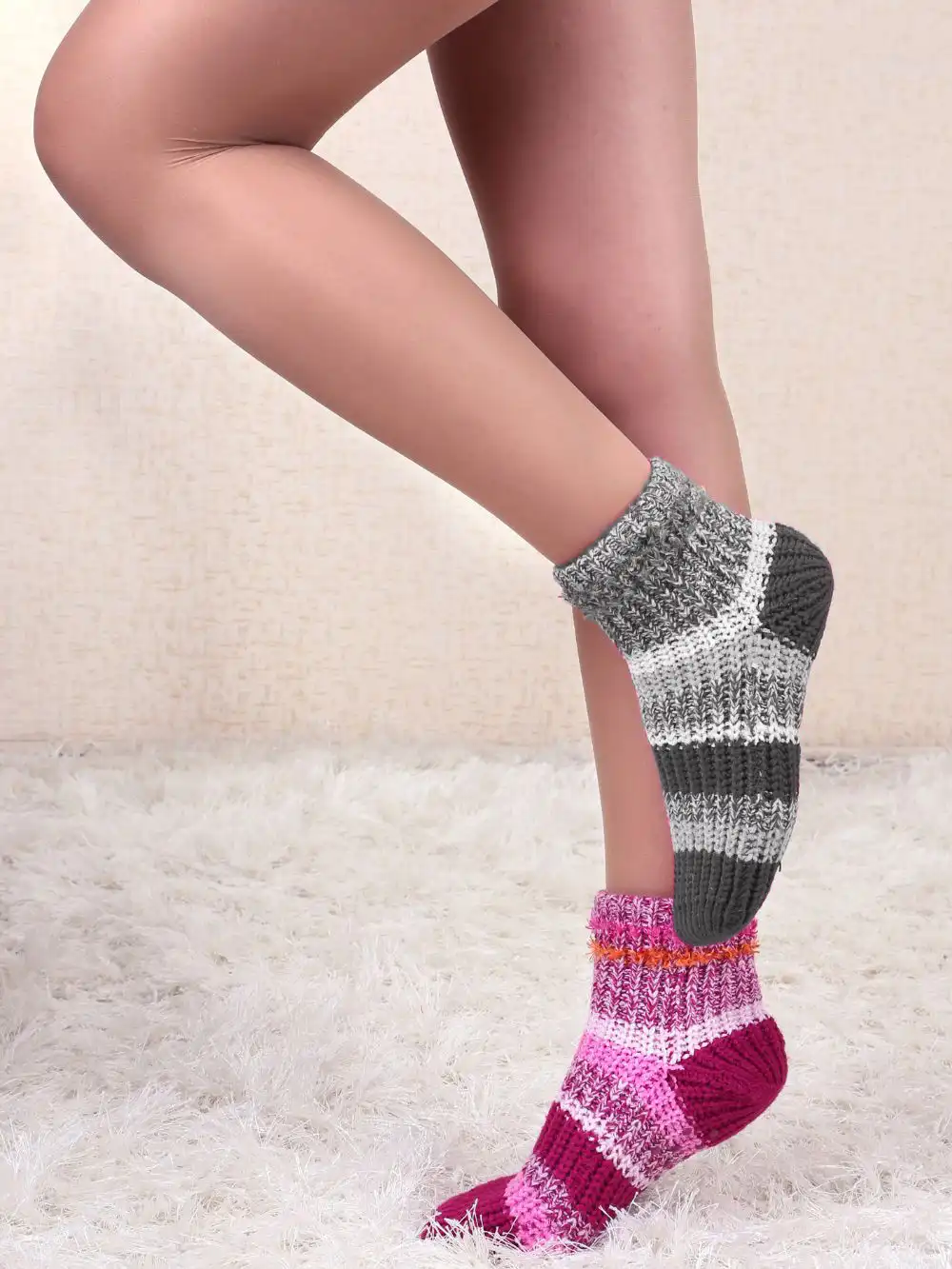Mismatched socks have become common, particularly among girls who embrace the unconventional. But what drives this trend? From adding an extra splash of color and pattern to making bold statements and defying societal norms, there are numerous reasons why girls opt for two different colored socks.
Whether it’s a fashion statement, an expression of individuality, a symbol of emotional maturity, or even a result of practicality, wearing mismatched socks has evolved into a fun and purposeful choice for many girls.
Let’s explore the beautiful world of mismatched socks of girls and discover the motivations for this quirky and stylish trend.
Why do girls wear two different colored socks?
To express extra color and patterns
Girls wear two different colored socks for fun and style. They like the extra color and patterns it adds to their outfits. By mixing colors and patterns in their socks, girls create interesting combinations girls think to look good.
The mismatched socks become a fun part of their style. Many girls start doing this as kids. They like how different and unique mismatched socks make them look. As they grow older, mismatched socks stay a fun way for girls to express their personalities.
Sometimes girls match one sock to their outfit and wear a brightly colored sock on the other foot. This gives a pop of color to plain outfits. Girls see wearing mismatched socks as a little rebellion. They like breaking the ‘rules’ of matching socks.

To make a statement
Some girls wear mismatched socks to make a statement. They do this to defy society’s ideas about beauty and perfection. Many people think that matching clothes and symmetry are more attractive.
But some girls purposefully mismatch their socks to go against this idea. They want to show that difference, and imperfection can also be beautiful. They want to break society’s rules of perfectly matching clothes.
By wearing two plainly different socks, these girls send a message. They show that beauty does not need to be perfectly symmetric. Their mismatched socks show that society should accept everyone regardless of perceived imperfections.
The unique combinations of different colored and patterned socks can also be seen as art. The mismatched socks become a type of self-expression. They let others know that this girl does not follow traditional ideas of attractiveness. She makes her own rules.
Because of emotional maturity
Many girls wear two different colored socks just for fun or style. But some experts believe that wearing mismatched socks can show a level of emotional maturity.
Individuals who mismatch their socks unintentionally may display higher self-confidence and security in their identity. They show that they do not need to conform to social norms about fashion and symmetry. They are comfortable being themselves regardless of what others think. This indicates emotional strength and maturity.
People who are emotionally immature often have a strong desire for external validation. They aim to please others and conform to perceived standards. Truly mature individuals are more internally driven. They follow their own path, even if it goes against social norms.
Mismatched socks become a manifestation of this inner confidence and security. These girls display that they are comfortable enough in themselves to ignore the “rules” and make their own choices.
Unorganized yet prioritized
Many girls wear two different colored socks for fun or style. But mismatched socks can also metaphorically show the kind of girl with an unorganized yet prioritized life. She may appear disorganized to outsiders with mismatched socks and messy hair. But internally, she knows her priorities.
The tasks and people most matter to her get her time and effort. The rest do not make the “cut,” like finding matching socks every morning. She values comfort, spontaneity, and authenticity over perfection. Her life has a purpose, more than a perfect appearance. She accomplishes what really matters to her, even if it makes her closet or desk seem chaotic.
Her mismatched socks show she values ease and function over the obsessive organization. Others may judge her socks as ‘wrong’. But for this girl wearing mismatched socks feels right. They reflect the type of life she chooses. Unorganized yet purposeful. Chaotic yet aligned with her true priorities.
Due to a lack of options
For some girls, wearing two different colored socks happens because of a lack of options. Small and extra-small adult socks are hard to find. Many women and girls with petite feet have trouble finding regular socks that fit well.
Few women’s socks in tiny sizes exist when small feet outgrow children’s socks. Most normal socks are too long and big. This forces some girls to wear children’s socks. But since children’s socks mainly come in multi-packs with different colors, matching two socks gets impossible.
Girls have to wear whatever clean children’s socks they find. This causes mismatched socks. Girls with small feet often face trouble finding proper-fitting socks, bras, shoes, and clothes.
Clothing companies ignore this niche market. So these girls make do with ill-fitting adult sizes or children’s sections. Their mismatched socks happen not by fashion choice but as a necessity. They want regular-fitting socks in their size but must manage with whatever is available.

To get the awareness
Some girls wear two different colored socks on March 21st, World Down Syndrome Day. This practice began as a way to raise awareness and support for people with Down syndrome. Down syndrome happens when a person has an extra copy of chromosome 21.
The mismatched socks are meant to symbolize the shape of chromosomes. Girls and women wear one orange sock and one black sock on this day. The orange sock represents the extra chromosome, and the black represents the two typical chromosomes.
Wearing mismatched socks on World Down Syndrome Day aims to start conversations about the condition. It helps create a more inclusive society that supports people with Down syndrome.
The mismatched sock trend focuses on ability, not disability. It reminds people that those with Down syndrome are just like everyone else, although they think and learn differently. The brightly colored odd socks symbolize inclusion, acceptance, and celebration of diversity.
As a style
Many girls wear two different colored socks simply for style. Mismatched socks can add personality and character to an otherwise plain outfit. The mix of colors, patterns, and textures in odd socks provides a creative way for girls to express individuality through their clothing. While matching socks may seem more proper or formal, mismatched socks can be seen as joyful and whimsical.
Wearing odd socks lets girls infuse their style with fun, unconventional elements. Brightly patterned or novelty socks become accent pieces that steal the eye. Even noticeable logos or brands on mismatched socks can turn an ordinary look into something attention-grabbing.
Colors or patterns that clash intentionally may demonstrate a girl’s fearless embrace of self-expression through her fashion choices. Overall, mismatched socks provide a creative outlet for girls to exhibit originality, make a statement, and maintain their personal style, all while bringing a smile.
Because of comfort
For some girls, comfort is the main reason for wearing two different colored socks. One sock may be stretchier or thicker than the other. This creates a better fit on one foot.
Some girls have sensory processing issues that impact how clothes feel. Textures, tags, and tightness can irritate the skin and make it feel uncomfortable.
Wearing mismatched socks helps because each sock has a different texture. This provides two different sensations that are easier for the girl’s brain and body to process.
Odd socks’ different thicknesses or materials can create comfortable pressures and tensions. For girls with nerve sensitivities, having one tighter-fitting sock and one looser sock allows room for swelling that occurs throughout the day. The mismatch solves the problem of both socks feeling uncomfortable in their own ways.
Because of laziness or forgetfulness
For some girls, mismatched socks result from laziness or forgetfulness rather than intention. In a rush to get out the door, girls may grab whatever clean socks are nearby without bothering to check that they match.
Finding and pairing matching socks requires extra time and effort that lazy girls do not wish to expend. They value convenience over perfectly coordinated outfits.
Similarly, girls may accidentally wear mismatched socks because they do not notice the color difference. Especially in the early morning rush, girls’ brains are not fully functioning yet. Wearing odd socks may go undetected until they arrive at school or work.
Even when girls do realize they have mismatched socks, they may decide it is not worth the trouble to change. The emotional and time costs of finding a replacement sock seem too high. So they keep the odd socks, reasoning that few people will notice.
Laziness and lack of attention likely explain many instances of girls wearing two different colored socks.
To annoy siblings
For some girls, wearing mismatched socks is a form of sibling teasing or payback. Younger sisters may mismatch their socks to annoy their older brothers or sisters.
The older sibling’s preference for proper clothing coordination and rules irks the younger sister. She wears odd socks on purpose, knowing it will irritate her sibling. This becomes a way for the younger sister to express frustration at the rules imposed on her.
Wearing unexpected mismatched socks feels like a small rebellion against an otherwise strict or conservative household. The odd socks symbolize the younger sister’s independence and individuality. She mismatches them to get under her sibling’s skin and demonstrates that she will not always conform.
While annoying to the rule-following older sibling, the odd socks show the younger sister’s playful spirit and tension that naturally exists between brothers and sisters at different life stages.

Because of personal preference
Many girls prefer the look of mismatched socks. They enjoy pairing bright colors, patterns, and textures that traditional matching never allows. By mismatching their socks, these girls show a personal preference for self-expression over conformity. They appreciate the quirkiness and uniqueness that odd socks add to an outfit.
Combining unalike socks allows girls to be creative with their clothing choices easily and carefreely. Making unusual color combinations that traditional rules would discourage allows girls to showcase their own individual sense of style.
Bolder girls may relish purposely going against norms by wearing mismatched socks. More reserved girls could still quietly appreciate the unexpectedly fun juxtapositions created by their odd socks.
Ultimately, many girls wear two different colored socks because they personally enjoy the non-traditional look and feel that mismatching allows. It reflects their own preferences rather than following others’ expectations.
What is the origin of the mismatched socks trend?
The origin of the mismatched socks trend is the convenience of wearing whatever clean socks are closest rather than searching for a matching pair.
People began unintentionally wearing mismatched socks as a timesaver when doing laundry. Over time, the trend spread, and designers began making unmatched novelty socks as a fashion statement.
Though mismatched socks have grown trendy recently, the practice has a long history. In the Middle Ages, Europeans donned socks of different colors to show off wealth. Mismatched socks later became associated with Down syndrome awareness by representing chromosomes.
Mismatched socks were likely firstborn from convenience and laziness. Yet the trend has persisted and evolved due to styling, individuality, and self-expression. Designers have capitalized on the trend, while celebrities like Justin Bieber and Rihanna have been seen wearing mismatched socks, and even fashion designers like Marc Jacobs have incorporated them into their collections.
Are left and right socks a thing?
Left and right socks are designed slightly differently to provide a better fit for each individual foot. While most regular cotton socks can be worn on either foot, some specialty socks are designed specifically for the left or right foot.
Specialty socks intended for athletic activities and certain occupations often benefit from being left and right-specific. These socks can provide the following:
- A better fit – Each foot has a unique shape, so socks designed specifically for left or right foot contours can reduce slippage and bunching.
- More support – Left and right socks are sometimes padded differently to match each foot’s specific pressure points and needs.
- Injury prevention – A proper fit helps reduce friction that can cause blisters. Supportive pads in the right location help absorb shock.
While many people wear regular socks interchangeably, left and right-specific socks may benefit those engaged in high-impact athletics or professions requiring long-standing periods. The tailored fit can boost comfort, performance and prevent foot problems.
Most regular socks are ambidextrous. But for those seeking maximum fit, support, and performance, left and right-specific socks have distinct advantages – especially for active individuals or those on their feet for long hours.

Summary
Girls wear two different colored socks for various reasons. Firstly, it allows them to express their individuality and style. Girls can create interesting combinations and unique looks by mixing colors and patterns. It becomes a fun way for them to showcase their personality and break the traditional rules of matching socks.
Secondly, some girls wear mismatched socks to make a statement and defy societal norms of beauty and perfection. They want to show that imperfections can be beautiful and that everyone should be accepted regardless of perceived flaws. Mismatched socks become a form of self-expression and art, signaling that they make their own rules.
Additionally, wearing mismatched socks can indicate emotional maturity. It suggests that these girls have higher self-confidence and security in their identity, as they are comfortable being themselves and not conforming to social norms.
For some girls, wearing mismatched socks is a matter of comfort. They may have sensory processing issues or prefer the different textures and sensations that mismatched socks provide.
Other reasons for wearing mismatched socks include lack of options in finding properly fitting socks, laziness or forgetfulness, sibling teasing or rebellion, personal preference for self-expression, and even as a way to raise awareness for Down syndrome on World Down Syndrome Day.
Overall, mismatched socks have become a popular trend among girls, allowing them to add color, creativity, and individuality to their outfits while making various statements about style, acceptance, and personal choices.
FAQ
What do black socks represent?
In the context of the 1968 Olympic Games, black socks were worn by two African American athletes, Tommie Smith, and John Carlos, during their medal ceremony to represent black poverty. It was a symbol of their protest against racial discrimination and their advocacy for human rights.
Are mismatched socks a trend?
Yes, mismatched socks have become a popular fashion trend in recent years. Many people intentionally wear mismatched socks to express their style, make a statement, or add fun and color to their outfits.
Are there male and female socks?
Yes, socks are often categorized by gender, with men’s socks generally being larger and thicker than women’s socks.
What type of socks do girls wear?
Some popular types of socks for girls include ankle socks, crew socks, knee-high socks, and slouch socks. Different socks are also worn for different activities, such as athletic socks for sports and dress socks for formal occasions.
Why do girls wear socks at night?
Socks can help regulate body temperature while sleeping by keeping feet warm, which can help improve sleep quality and promote relaxation. Additionally, wearing socks can also help keep feet moisturized and prevent dry, cracked skin. Some women also find that wearing socks to bed can help alleviate hot flashes and other symptoms associated with menopause.



